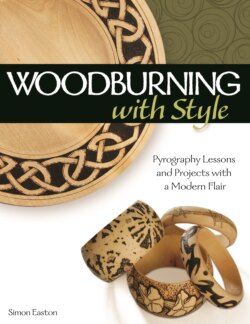Читать книгу Woodburning with Style - Simon Easton - Страница 38
На сайте Литреса книга снята с продажи.
Finishing Your Work
ОглавлениеHow to protect your finished work depends on the nature of the object you have created. If you are not sure what effects a particular varnish or oil may have on the wood surface or tones of your pyrography design, I would always recommend trying a small area on a piece of scrap wood first. It is much better to spend a bit of time doing this, rather than inadvertently ruining a finished piece of work at the final stages. This is particularly important in the future if you start to combine other materials, such as paint or ink, with your pyrography. There would be no bigger frustration than completing a design only to see the colors run when you start varnishing.
Keep in mind while applying that most varnishes have guidelines that show how long before a coat is touch dry, and how long it takes to dry completely. If you do not follow the instructions, the lower coats may not dry fully which affects each subsequent coat: sometimes the finished effect can appear rippled or dull. You cannot rush the process, so make sure you allow enough time to let each coat dry fully before you start the next application. Use a broad soft brush and apply the varnish sparingly. It is better to build up the layers gradually rather than applying too much at once, as this can result in drips or puddles, which do not dry particularly well and ruin the finished appearance.
Use a large soft paintbrush to apply varnishes to your crafted items, and remember to allow time to dry between coats. Always follow the directions on the container of the particular brand that you are using.
Apply Danish oil or other finishes to wooden items with a soft cloth.
Danish oil gives the wood a pleasing warm luster. The right side of this fob has been treated, while the left side is plain wood.
